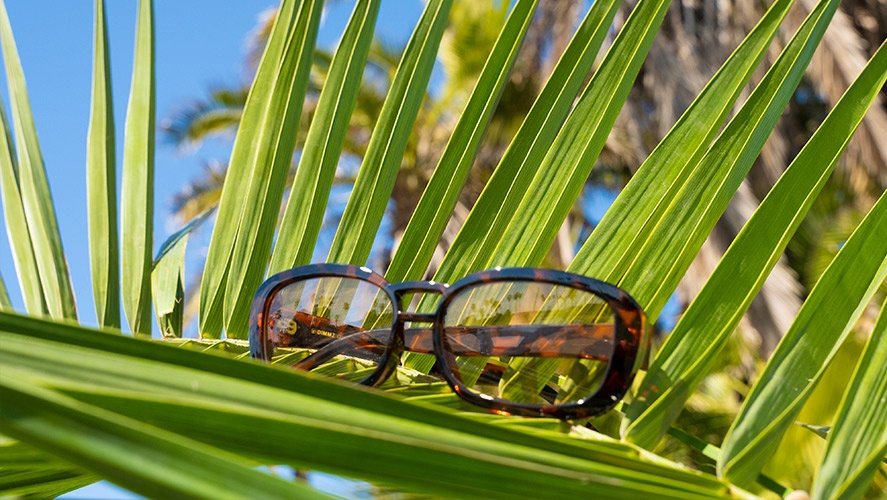
It is vital to protect your eyes from hazardous bright lights and other varied discomforts that may produce stress on your eyesight if you have a condition such as a cataract. Cataract symptoms range from blurriness and light sensitivity to glare and seeing yellow tints, and they can all affect your vision quality.
While eyeglasses and sunglasses can’t cure cataracts, they can help with the blurriness and discomfort they cause. Some aspects of cataract sunglasses may even aid in the prevention of the condition’s worsening.
The suggestions below might assist you in deciding on a new pair of glasses or sunglasses to address your cataract symptoms (s). Whether you’ve had special cataract therapy or have had cataract surgery, these suggestions may be beneficial to you.
The development of a cataract
A clouded lens is referred to as a cataract. The lens sits behind your colored area of the eye (iris). The lens concentrates light entering your eye, resulting in bright, sharp pictures on the retina, the light-sensitive membrane in your eye that works similarly to film in a camera.
The lenses in your eyes lose flexibility, transparency, and thickness as you get older. Proteins and fibers within the lenses break down and clump together as a result of aging and other medical disorders, causing the lenses to become cloudy.
The clouding in the eye grows heavier as the cataract progresses. As light passes through the lens, a cataract scatters and filters it, preventing a clear image from reaching your retina. Your eyesight will get hazy as a result of this.
Cataracts usually develop at the same time in both eyes, although not always. One eye’s cataract may be more progressed than the other, resulting in a visual discrepancy between the two.
Cataracts have several different types.
- The following are the many kinds of cataracts :
The lens’s center is affected by cataracts (nuclear cataracts). Initially, a nuclear cataract may result in increased nearsightedness or even a transient improvement in reading vision. However, when the lens becomes more thickly yellow over time, your vision becomes increasingly obstructed.
The lens of the eye may turn brown as the cataract advances. Advanced lens yellowing or browning can make it difficult to discriminate between different tones of color.
Cataracts that impair the lens’s edges (cortical cataracts). The first signs of a cortical cataract are white, wedge-shaped opacities or streaks on the lens cortex’s outer border. The streaks gradually expand to the center of the lens, interfering with light flowing through the center.
Cataracts that impair the lens’s rear surface (posterior subcapsular cataracts). A posterior subcapsular cataract begins as a tiny, opaque patch near the rear of the lens, directly in the light path.
A posterior subcapsular cataract can create glare or halos surrounding lights at night, as well as obstructing reading vision. Cataracts of this kind progress more quickly than cataracts of other types.
You were born with cataracts (congenital cataracts). Cataracts are present from birth in some persons and form later in life in others. These cataracts might be inherited or caused by an illness or trauma during pregnancy.
Myotonic dystrophy, galactosemia, neurofibromatosis type 2 (NF2), and rubella are among disorders that can cause cataracts. Congenital cataracts don’t always impair vision, but when they do, they’re normally removed as quickly as possible after they’re discovered.
Sunlight and Cataracts
When the proteins in the lens of the eye begin to break down and clump together, cataracts occur. This happens naturally over time, although it can be accelerated by a variety of conditions, including prolonged sun exposure. As a result, the lens thickens and gets hazy, obstructing the passage of light. A cataract is 9the medical term for this. Surgery is the only effective therapy for cataracts once they form. A medically implanted artificial lens must replace the injured natural lens.
Sunglasses Provide Eye Protection
Wearing good sunglasses can help avoid a lot of the cataract-causing damage caused by the sun’s UV radiation. Wearing UV-blocking sunglasses while you’re young has been shown to lower your chances of having cataracts later in life. The goal is to choose sunglasses that block all UVA and UVB rays completely. UVA and UVB are ultraviolet radiation with different wavelengths that can harm your eyes. When it comes to sunglasses, many people take UV protection for granted. However, just because the lenses are darkly tinted doesn’t guarantee they’ll protect your eyes from UV rays.
UV protection is integrated into the lenses, rather than merely a coating on the lenses, in a trustworthy pair of UV-blocking sunglasses. The UV protection rating is often listed on the label, but you should double-check with your local optical store or your optometrist.
Sunglasses for Cataract
Everyone’s vision, especially those with cataracts, needs to be protected from the sun. The symptoms of cataracts can be exacerbated by exposure to sunlight, which can cause more damage to the eyes. Fortunately, there are several sunglasses on the market that are specifically made to assist with this.
- UV protection
Make sure your sunglasses claim 99-100 percent UVA and UVB protection, or 100 percent UV 400 protection, on the label or online description for optimum sun protection.
- Lenses that are polarized
Surfaces such as water and concrete can produce a lot of glare, which polarization can help to lessen. This function is especially useful for individuals who lead an active lifestyle, but it may also be used for ordinary tasks like driving.
- Framing that wraps around
Although most sunglasses cover the front of your eyes, it’s crucial to keep in mind that sunlight may also penetrate your eyes from the sides. All-access points to the sun are covered by wraparound frames, providing complete protection for your eyes.
What are the ideal colors of sunglasses for cataracts ?
For day-to-day tasks, yellow, amber, and orange will boost contrast. Cataracts – After cataract surgery, you may want to consider wearing amber or tinted amber lenses, which provide UVA/UVB protection, glare reduction, and overall comfort when outside.
How to Keep Your Eyes Safe
Wang claims that wearing sunglasses can assist to lessen the risk of injury. However, it all depends on whatever pair you choose and how you wear them.
- Expert advice on eye protection:
Make UV blocking a priority. “When buying for sunglasses, make sure they block out 99 to 100 percent of UVA and UVB rays while also blocking out 75 to 90% of visible light,” Pierce advises. The glasses may be labeled as providing “100% UVA and UVB protection” or “100% UV 400 protection,” indicating that they filter rays as tiny as 400 nanometers.
Take a look at the form. “The greatest sunglasses are ones that wrap around the face since they block light from all angles and give the most protection,” Wang explains.
Don’t be fooled by the tint’s hue. The protection is not determined by the hue of the lenses, according to Wang. “Glasses with a lighter tint can still provide enough protection. »
Pick “polarized” from the drop-down menu. Reflections from horizontal surfaces like water, snow, and a car’s hood are reduced with this lens. “While polarization isn’t required for further protection, it does help to lessen this form of eye strain,” Wang says.
Recognize that they aren’t just for hot days in the summer. Even on foggy days, experts recommend wearing sunglasses. The sun’s rays can be even more hazardous in the winter, according to Pierce, especially at high elevations and on reflecting materials like snow and ice. Second, clouds do not provide complete solar protection. “UV radiation still penetrates through partial sun or clouds, so sunglasses are still a good idea,” Wang explains.
Prioritize quality over brand recognition. For a pair of designer sunglasses, many individuals are ready to pay hundreds of dollars. Is that a good idea? “You’re often paying for the label and the appearance,” Wang explains. “However, they are more likely to use higher-quality lenses.”
According to him, low-cost sunglasses frequently fulfill the basic standards. “However, you should proceed with greater caution to guarantee that the lenses fit the requirements.” Any pair of sunglasses may be taken to an optician who will test the lenses to ensure that they give enough UV protection.
Put them on with your contacts in place. According to the American Optometric Association, while certain contact lenses provide UV protection, they should still be used alongside sunglasses to ensure maximum eye protection.
Children must not be forgotten. “Wearing sunglasses early in life is especially crucial since children generally spend far more time outside than adults,” Wang explains. “Sunglasses can help prevent harm later in life.”
Don’t limit yourself to sunglasses. “In addition to sunglasses, applying sunscreen around the eyes and wearing a cap or visor can aid boost protection,” Pierce explains.
Keep your gaze away from the sun. This is advice you’ve probably heard before during eclipses, but it’s true all the time. “It can cause temporary or permanent damage to the retina if someone looks straight at the sun without protection at any moment,” Wang explains.
Conclusion :
Cataracts are a somewhat common condition that may be treated. You should, however, look after your eyes. Wear sunglasses both before and after cataract surgery if you have cataracts. The information provided above might assist you in locating the best sunglasses for cataracts available anywhere on the planet. If you or your companion has cataracts, wear sunglasses to protect your eyes from blue light, UV rays, and intense sunshine. Purchase one of the top cataract sunglasses in the globe listed above.
